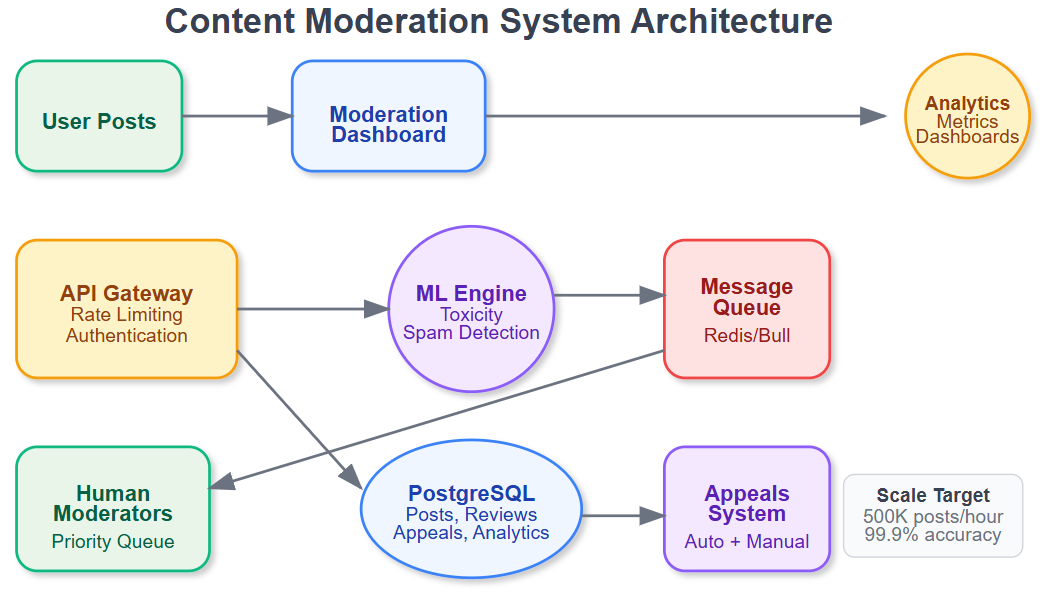Lesson 28: Building a Twitter-Scale Content Moderation System
What We’re Building Today
You’re about to build the guardian of your Twitter clone - a content moderation system that processes half a million posts every hour while keeping your platform safe. Think of it as your digital bouncer that never sleeps, never gets tired, and learns from every interaction.
Today’s Agenda:
Multi-layer automated content filtering with ML models
Human review workflows for edge cases
Appeal system for contested decisions
Real-time processing pipeline handling 500K posts/hour
Why This Matters in Production Systems
Every major social platform battles the same challenge: how do you moderate billions of posts without killing user experience? Twitter’s actual moderation system processes over 500 million tweets daily using a sophisticated pipeline that combines AI detection, human oversight, and automated appeals.
Your system will mirror this real-world architecture, teaching you patterns used by platforms serving billions of users.
Core Concepts: The Multi-Layer Defense Strategy
The Pipeline Architecture
Content moderation isn’t a single filter - it’s a sophisticated pipeline where each layer catches different types of harmful content:
Layer 1: Pre-publication Scanning - Blocks obvious violations before they reach users
Layer 2: Real-time Monitoring - Continuously scans published content
Layer 3: Community Reporting - Leverages user reports for contextual violations
Layer 4: Appeal Processing - Handles contested moderation decisions
The Detection Engine
Your ML models work like specialized detectors:
Text Classifier: Identifies hate speech, spam, and misinformation patterns
Image Analyzer: Detects inappropriate visual content using computer vision
Behavioral Detector: Spots coordinated inauthentic behavior and bot networks
The Human-AI Collaboration
Pure automation fails at scale because context matters. Your system implements a hybrid approach where AI handles clear-cut cases while humans review ambiguous content, creating a feedback loop that continuously improves detection accuracy.
Context in Distributed Systems
Integration with Your Twitter Architecture
Your content moderation system sits between your stream processing pipeline (Lesson 27) and your search infrastructure (Lesson 29). It receives posts from Kafka streams, applies ML filtering, routes complex cases to human reviewers, and feeds clean content to your search indexes.
Data Flow Integration:
User Post → Stream Processing → Content Moderation → Search Indexing → User Feeds
Scalability Challenges
Processing 500K posts/hour means your system must:
Handle traffic spikes during viral events
Maintain sub-second response times for real-time filtering
Scale human review capacity dynamically
Process appeals without creating bottlenecks
Architecture Deep Dive
Component Architecture
Content Ingestion Service - Receives posts from Kafka streams and initiates moderation workflow
ML Detection Engine - Runs multiple specialized models in parallel for comprehensive content analysis
Human Review Queue - Manages workflow for human moderators with priority routing and workload balancing
Appeal Processing System - Handles user appeals with automated and manual review stages
Decision Engine - Coordinates between automated and human decisions, maintaining audit trails
Notification Service - Informs users about moderation actions and appeal outcomes


